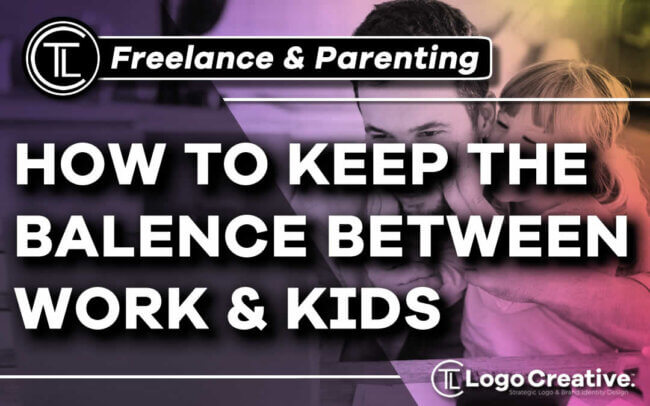Let’s face it, most of us parents would rather be stomping in muddy puddles with our kids than doing yet more work. But our bank balances wouldn’t thank us for it. So, no matter how challenging it might be, we have to find a way to make freelancing and kids fit. In this article, we discuss Freelance & Parenting: How to Keep the Balance Between Work & Kids.
I started freelancing two years ago just after my son was born.
Like many new and expecting parents, I realised I didn’t want to spend hours of my day commuting to and from the workplace when I could be spending that time with family.
But also like a lot of parents who work from home, I found that over time, my family and work life started to merge – to the point where I’d be researching a blog post while helping my toddler eat his lunch. Inevitably. Unsurprisingly, I did neither thing well.
If you’ve struggled to find a balance between your freelance work and your kids, this article is for you.
Here, I discuss the strategies that have helped me keep my work and parenting (mostly) apart.
Table of Contents
Be Clear About Your Goals
Now, this isn’t an article about motivation, so why am I talking about setting goals? Well… take it from someone’s who’s repeatedly tried to do everything I write about below without clear goals in mind and failed miserably, many times.
Goals help us stay focused and motivate us to keep doing difficult things – like saying “NO” to taking an impromptu play and cuddles break.
- Do you have a particular monthly income goal in mind?
- Are you saving for something?
- Do you want to diversify your portfolio over the next year?
- Are you trying to shake difficult clients and replace them with new ones?
Whatever you want to achieve in your professional life, make it clear in your mind… then in your workspace as well.
Right now, I’m writing in front of a Blue Peter style “fundraiser” chart (mine doesn’t quite go up to a million).

Every time I send an invoice, I colour a chunk of that little bar. When it’s full, I’ll have enough money to re-fence my woodland and plant some trees (I’m not even joking, that is my goal).
It might sound odd, but when all I want to do is snuggle on the sofa with my son, the thought of getting outside and planting trees with him in the near future gets me back in front of that computer.
Whatever your goal is, just make sure it’s SMART and highly visible. SMART goals are those that are specific, measurable, achievable, relevant and timely.
For example:
“I will earn £400 above my average household spending each month for 12 months to save for a family campervan.”
- Specific: If I was being non-specific, I could have said “save for a campervan”.
- Measurable: in the example above, “£400 above my average household spending each month” is the part that makes it measurable. If I’d just said “save for a campervan”, that doesn’t give me a value to work towards either in the long-term or short-term.
- Achievable: If your goal is monetary and you aim to save more than you can with your current rates and client list, you either need to charge more and get new clients or lower your goal to something achievable.
- Relevant: This means setting goals that feel relevant to you. Aiming to reach a six-figure income within a year might sound like a great goal to some, but if, like me, you’re not particularly materialistic, earning more than a comfortable income feels irrelevant.
- Timely: This is the “each month for 12 months” bit. If there’s no time element to your goal you’ll find it hard to measure it consistently.
Goal setting is a particularly important step in the process for creative freelancers because it’s much easier to get into a flow if you’re feeling positive.
Without goals, the actions below might just pile on the stress and roadblock your work.
Set Clear Boundaries
If you’ve been freelancing a while you’ve probably read a lot about setting clear boundaries.
But people are usually mean between you and your client, not you and your kids.
As you know, “boundaries” are not something kids are naturally good at…

So how can you help them understand that there’s a divide between work life and the rest of life?
For a start, it’s a lot easier to do it when you have a physically separate working space. Yes, your kids can still come barging into your office whenever the mood takes them – which it often does.
… But children do understand boundaries better when they’re conceptually linked something physical like a room.
For example, when this door is closed, mummy is working and can’t play’ is easier for a child to understand than ‘between 9am and 5pm mummy is working and can’t play’.
If you don’t have a separate place in the home specifically for work, the below will be more challenging. However, as with everything you have to teach children, persistence is key.
Boundaries are set by clear communication and reinforced by repetition.
Make sure you:
- Use consistent language: a toddler will find it harder to understand that you can’t play when you are holding your computer if half the time you call it a laptop. When you reinforce a rule, explain it the same way every time.
- Link the rule to something visible: if you have a home office, this can be the room itself, e.g. ‘when mommy’s in the office, she can’t play’. If you don’t, try tying it to an object, e.g. ‘when mommy’s on the computer, she can’t play’.
- Communicate the consequences of breaking the boundary: I’m not talking about punishment here, but the real-world consequences of that boundary being broken. In this case, the real-world consequence of being repeatedly interrupted while you’re working is probably that you will have to work more that day. So the consequence you communicate could be that if you keep interrupting mommy when she’s in the office/on the computer, she won’t be able to play at lunch time.’
- Let the consequences play out: this might sound mean, but even if you don’t need to lose out on play time because of interruptions, you don’t need to do it anyway. Consequences are hard to remember if they aren’t consistently enforced.
Establishing any new rule is difficult in the beginning – anyone who’s toilet-trained a toddler knows this.
But it will get easier over time with consistent communication and enforcement of the rules. And as your work/play boundary starts to set, you’ll find yourself less stressed.
Create and Stick to a Routine
To set clear boundaries, you need to have and stick to a routine. Routines help children understand what to expect and, therefore, work out why when something’s changed because of something they’ve done, e.g. they break a boundary.
Routines also help alleviate some of that parent-guilt you get when you work at home – especially with children who are home with you all day.
When you set aside time to be with your kids (lunch time Peppa Pig anyone?) you won’t feel so bad about shutting yourself away for the rest of the day.
Plus, you’ll both get to look forward to time together.
No two people’s routines look the time. But they all need to work around certain daily certainties like the school run, nap time, nursery pick up, etc.
When creating a new routine, start by noting down anything in your day that is fixed. Then note the times you are most effective at work.
For me, that’s early in the morning and late in the evening. For you, it might be different.
Schedule mundane tasks like business admin for the parts of the day you are less creative/effective. Save the the rest for creative work.
Once you have your daily certainties and effective hours written down, you’ll be able to see:
- When should you schedule creative work
- When you’re likely to need breaks
- What times and days work and don’t work for meetings
- When you can and can’t take or book client calls
And then what time do you have free to spend with your kids, do some marketing or update your freelance website.
I use Google Cal to organise my life but any basic calendar or simple organisational app will do). We have a family schedule and individual work schedules.
We all have access to an overview where all the schedules are smooshed together and that makes communication between myself, my husband and our son a lot easier.
Involve Your Children in the Process
This is the part that usually gets lost. But it’s the most important.
As any parent who’s let their kids “help” make dinner knows, children love to be involved. And children are more accepting of rules when they help make them.
Now, I’m not suggesting that you draw up your schedule with the committee during a family meeting. But smaller gestures can make a big difference. For example:
- Ask your child to make a sign for your office door. This is a fun process and reinforces the idea that the office is a space for a particular activity. Plus, making a sign for your private room makes your child feel involved in that part of your life.
- Ask your child which part of the day they prefer spending time with you. You might be surprised. They might prefer you in the mornings because you’re more energetic (that’s got to be true for someone, right?). Or maybe they prefer your evenings because you’re less stressed when the work day is over. Try to fit their preferences into your schedule and they’ll feel less put out about losing you for large parts of the day.
- Ask your child to choose one activity you do together each week. If my son knows we’re going to the beach tomorrow, he’s much more likely to be ok with me working a lot that day. Give your child something to look forward to and they won’t miss you as much.
Another way I help my son feel involved in the process of work is to explain to him why I have to do it.
For example, when I’m in the shop with my son and he asks for a toy, I explain to him that mummy will need to work a bit extra that week to buy that toy and ask if he’s ok with that.
Not only does it save me a lot of money by buying toys he doesn’t need, it also helps him understand why I don’t want to be interrupted when I’m at work and why I seem to “choose” work over him sometimes.
That’s a Wrap
If you’ve found a strategy that helps you keep the balance with your kids, tell us about it in the comments below.
Join The Logo Community
We hope you have enjoyed this article about Freelance & Parenting: How to Keep the Balance Between Work & Kids.
If you would like more personal tips, advice, insights, and access to our community threads and other goodies, join me in our community.
You can comment directly on posts and have a discussion.
*TIP – We use and recommend GrindKit. This is every document you need to work remotely to land bigger clients. Save 20% off with our link and you won’t regret it Trust us!
 Author bio
Author bio
Jodie is a Conversion Copywriter & Content Strategist working with B2B SaaS & tech brands. Before founding This Copy Sticks, she spent a decade selling value propositions, raised £2 million for charities. After 10 yrs of fundraising, she helps tech-mad trailblazers grow their business.


